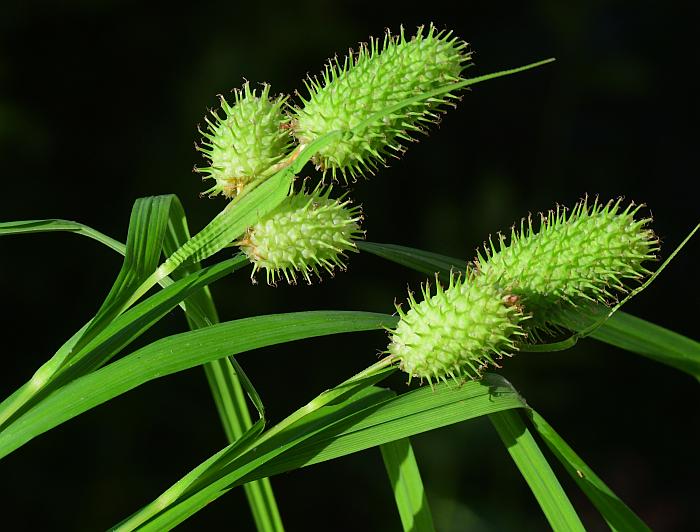Carex typhina Michx.
Cattail Sedge

Native
CC = 7
CW = -5
MOC = 34
© SRTurner
Carex typhina Michx.Cattail Sedge | |
 |
Native CC = 7 CW = -5 MOC = 34 |
© SRTurner |
|
Family - Cyperaceae Habit - Monecious sedge with short rhizomes, forming dense clumps. Stems - Vegetative stems well developed, leafy. Flowering stems erect, to 90 cm, sharply trigonous, brown at the base, glabrous.
Leaves - Blades 2-40 cm long, 4-10 mm wide, flat with the margins usually curled under. Sheaths with the tip not extended past the insertion point of the leaf, shallowly concave, the ligule longer than wide and V-shaped, the ventral side thin, papery, and white to light tan, the lowermost sheaths brown to nearly black.
Inflorescence - Inflorescence with 1-6 spikes loosely spaced near the tip of the axis, the lowermost bract lacking a sheath or nearly so.
Spikes - Terminal spike pistillate toward the tip and conspicuously staminate toward the base, the pistillate portion 15-45 mm long, 10-20 mm wide, narrowly oblong-elliptic to narrowly ovate in outline, rounded at both ends, the staminate portion 4-12 mm long, linear to narrowly obtriangular. Lateral spikes (if present) 1-5, similar to the terminal one, but entirely pistillate or less commonly with a few staminate flowers at the base. Staminate scales 4-8 mm long, oblanceolate to narrowly lanceolate, the tip bluntly to sharply pointed, orangish brown with a green midrib and lighter margins. Pistillate scales 4-6 mm long, oblanceolate to lanceolate, the tip bluntly to sharply pointed, shorter than the perigynium and mostly obscured by it, orangish brown with a green midrib and lighter margins.
Perigynia - Perigynia 5-9 mm long, mostly spreading, but with the beaks mostly ascending, the surface with 2 ribs, otherwise nerveless or with 5-9 faint nerves, yellowish green to brown at maturity. Styles straight or nearly so. Fruits with the main body 2.2-3.0 mm long, elliptic in outline, trigonous with somewhat concave sides and rounded angles, dark brown to nearly black, often somewhat iridescent.
Flowering - April - September. Habitat - Swamps, bottomland forests, bottomland prairies, prairie swales, pond margins, riverbanks, marshes, ditches, moist roadsides. Origin - Native to the U.S. Lookalikes - Carex squarrosa, C. frankii. Other info. - This attractive sedge is not particularly common in Missouri. Populations are concentrated in the Bootheel region and in a diagonal band extending southwestward from the northeast corner of the state. It is likewise found in scattered locations throughout much of the eastern half of the continental U.S. Characters aiding identification include the large spikes, staminate regions at the spike bases rather than in a discrete staminate spike, and perigynia with conspicuous beaks. The plant is easily confused with the more common C. squarrosa, which it strongly resembles. The perigynium beaks of C. typhina are more strongly ascending, but this character is subtle. More definitive is the shape of the styles (which are persistent on the achenes found inside the perigynia), which are strongly contorted in C. squarrosa but straight in C. typhina. Photographs taken at Robertsville State Park, Franklin County, MO, 9-6-2019 and 6-10-2020 (SRTurner). |